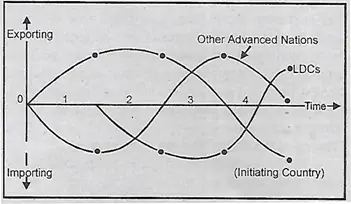Phases of the International Product Life Cycle.
The Important Phases of International Product Life Cycle are:
- Introduction and growth.
- Maturity.
- Decline
- Import.
Introduction and Growth:
The first phase of international product life cycle is introduction and growth during which innovative (exporting) country’s export strength is evident. Product innovation is likely to be related to the needs of the home market. The firm usually serves its home market first.
The new product is produced in the home market because, as the firm moves down the production learning curve, it needs to communicate with both suppliers and customers. After meeting the demand of the home country, the manufacturers start exporting foreign market and exporting goods to them. Thus, export strength is evident by innovator country.
Maturity:
The next phase of international product life cycle shows the stage where the production activities start shifting from innovating country to other countries, i.e., foreign production starts. The importing firms in the middle income country realize the demand potential of the product on the home market. The manufacturers also become familiar in producing the goods.
The growing demand of the products attracts the attention of many firms. They are tempted to start production in their country and gradually start exporting to the low income country. The large production in the middle income country reduces the export from the innovating country.
Decline:
Decline is the third phase in which foreign production becomes competitive in the export market. The firms in low income country also realize the demand potential in the domestic market. They start producing the products in their home country by exploiting cheap labor.
They gain expertise in manufacturing the commodity. They become more efficient in producing the goods due to low cost of production. Gradually they start exporting the goods to other countries. The export from this country replaces the export base of innovating country, whose export has been already declining. This exhibits the declining stage of product life cycle for the innovator country. In this stage, the product gets widely disseminated and other countries start imitating the product.
Import:
In the last phase of international product life cycle, import competition begins. The producers in the low income importing country gain sufficient experience in producing and marketing the products. They attain the economies of scale and gradually become more efficient than the innovator country.
At this stage, the innovator country finds the import from this country advantageous. Hence, the innovator country finally becomes the importer of that product. In this fourth stage of product life cycle the product becomes completely standardized.

International product life cycle shows that advanced (initiating) countries play the innovative role in new product development. International product life cycle presents the following implications for planning of the product:
- Innovative products carry significant potential for international marketing.
- The marketer whose products face declining sales in one foreign market may find another foreign market with encouraging demand for his product, and
- Innovative products improve the staying power of the international firm.


